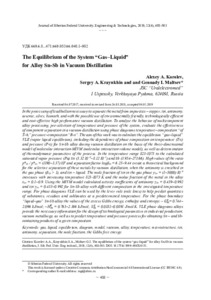Равновесные системы «газ–жидкость» для сплава Sn-Sb при вакуумной дистилляции
Скачать файл:
URI (для ссылок/цитирований):
https://elib.sfu-kras.ru/handle/2311/110392Автор:
Королев, А.А.
Краюхин, С.А.
Мальцев, Г.И.
Korolev, Alexey A.
Krayukhin, Sergey A.
Maltsev, Gennady I.
Дата:
2019-06Журнал:
Журнал Сибирского федерального университета. Journal of Siberian Federal University. Engineering & Technologies, 2019Аннотация:
При переработке чернового свинца необходимо отделить металл от примесей – меди, олова,
сурьмы, мышьяка, серебра, висмута с возможным использованием экологически безопасной,
технологически эффективной и экономически выгодной высокопроизводительной вакуумной
дистилляции. Для анализа поведения поликомпонентного сплава в процессе переработки,
предварительного выбора температуры и давления системы, оценки эффективности
разделения компонентов при вакуумной перегонке используют фазовые диаграммы
температура–состав «Т–х» и давление–состав «Р–х». Цель работы состояла в расчете
равновесных состояний «газ–жидкость» VLE (vapor liquid equilibrium), включая зависимости
состава фаз от температуры (Т-х) и давления (Р-х) для Sn-Sb-сплава при вакуумной перегонке
на основе объемной модели молекулярного взаимодействия MIVM (мolecular interaction
volume model), а также определение термодинамических параметров процесса. В интервале
температур 823–1073 К рассчитаны давления насыщенного пара (Па) для Sn (3,32.10–9–8,12.10–5)
и Sb (3,954–273,66). Высокие значения соотношения р*Sb / р*Sn = (1190–3,37).106 и коэффициента
разделения logβSb = 6,25–9,44 создают теоретические предпосылки для селективного выделения
этих металлов вакуумной дистилляцией, когда сурьма обогащается в газовой фазе (βSb > 1), а
олово – в жидкой. Мольная доля олова в газовой фазе уSn = (1–5000).10–9 увеличивается с ростом
температуры 823–1073 К и мольной доли металла в сплаве хSn = 0,1–0,9. С использованием
модели MIVM рассчитаны коэффициенты активности сурьмы = 0,439–0,992 и олова = 0,433–
0,992 для Sn-Sb-сплава различного состава в исследованном температурном диапазоне. Для
фазовых диаграмм VLE может быть использовано правило рычага (правило отрезков) для
прогнозирования количества вещества, остатков и возгонов при заданной температуре. Для
границы раздела фаз «жидкость–газ» Sn-Sb-сплава определены значения избыточных энергии
Гиббса, энтальпии и энтропии: ����� ���������� �����
= 0,744–2,096 кДж/моль; –
= 0,763–2,166 кДж/моль;
= 0,0181–0,0891 Дж/моль.К. Фазовые диаграммы VLE сплавов обеспечивают необходимой
информацией для проектирования технологических параметров промышленного производства
вакуумной металлургии, а также для прогнозирования температуры и давления процесса с
целью получения Sn- и Sb-содержащих продуктов заданного состава In the processing of lead bullion necessary to separate the metal from impurities – copper, tin, antimony,
arsenic, silver, bismuth, and with the possible use of environmentally friendly, technologically effi cient
and cost-eff ective high performance vacuum distillation. To analyze the behavior of multicomponent
alloy processing, pre-selection of temperature and pressure of the system, evaluate the eff ectiveness
of component separation in a vacuum distillation using phase diagrams temperature–composition “of
T–h,” pressure–composition “R–x”. The aim of this work was to calculate the equilibrium “gas–liquid”
VLE (vapor liquid equilibrium), including the dependence of phase composition on temperature (T-x)
and pressure (P-x) for Sn-Sb alloy during vacuum distillation on the basis of the three-dimensional
model of molecular interaction MIVM (мolecular interaction volume model), as well as determination
of thermodynamic parameters of the process. In the temperature range 823-1073 to the calculated
saturated vapor pressure (Pa) Sn (3.32.10–9–8.12.10–5) and Sb (3.954–273.66). High values of the ratio
р*Sb / р*Sn = (1190–3.37).106 and separation factor logβSb = 6.25–9.44 create a theoretical background
for the selective separation of these metals by vacuum distillation, when the antimony is enriched in
the gas phase (βSb > 1), and tin – liquid. The mole fraction of tin in the gas phase уSn = (1–5000).10–9
increases with increasing temperature 823-1073 K and the molar fraction of the metal in the alloy
хSn = 0.1–0.9. Using the MIVM model calculated activity coeffi cients of antimony γSb = 0.439–0.992
and tin γSn = 0.433–0.992 for Sn-Sb alloy with diff erent composition in the investigated temperature
range. For phase diagrams VLE can be used by the lever rule (rule lines) to help predict quantities
of substances, residues and sublimates at a predetermined temperature. For the phase boundary
“liquid–gas” Sn-Sb alloy the values of the excess Gibbs energy, enthalpy and entropy:
= 0.744–2.096 kJ/mol; –
= 0.763–2.166 kJ/mol;
= 0.0181–0.0891 J/mol.K. VLE phase diagrams alloys
provide the necessary information for the design of technological parameters in industrial production,
vacuum metallurgy, as well as to predict temperature and pressure process for obtaining Sn – and Sbcontaining
products of a given composition

